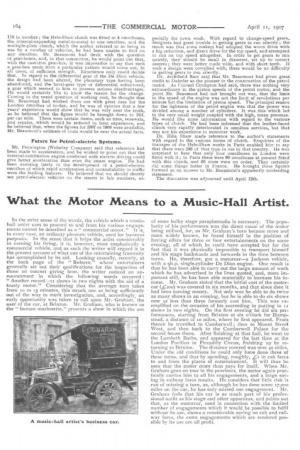What the Motor Means to a Music-Hall Artist.
Page 34

If you've noticed an error in this article please click here to report it so we can fix it.
In the strict sense of the words, the vehicle which a musichall artist uses to proceed to and from his various engagements cannot be described as a" commercial motor." It is, in every case, an ordinary pleasure vehicle, used for business purposes. In the sense that it helps the artist considerably in earning his living, it is, however, most emphatically a commercial vehicle, and as such the writer will regard it in the present account of what one of the entertaining fraternity has accomplished by its aid. Looking casually, recently, at the back page of the " Referee," where entertainers generally set out their qualifications for the inspection of those on concert giving bent, the writer noticed an announcement in which the following words occurred : "Another record--ii shows in two nights with the aid of a trusty motor." Considering that the average turn takes from so to 15 minutes, this struck one as being sufficiently out of the way to merit investigation, and, accordingly, an early opportunity was taken to call upon Mr. Graham, the user of the car, at Brixton. Mr. Graham, who is known as the " human marionette," presents a show in which the use of some bulky stage paraphernalia is necessary. The popularity of his performance was the direct cause of the motor being utilised, for, as Mr. Graham's turn became more arid more widely known, he found himself in the position of having offers for three or four entertainments on the same evening, all of which he could have accepted but for the fact that it was physically impossible to transport himself and his stage backwards and forwards in the time between turns. He, therefore, got a motorcar—a Jackson vehicle, with a gh.p, single-cylinder De Dion engine. One result is that he has been able to carry out the large amount of work which he has advertised in the lines quoted, and, more important still, he has been able materially to increase his income. Mr. Graham stated that the initial cost of the motorcar (Z2oo) was covered in six months, and that since then it had been earning money. Not only was he able to do twice as many shows in an evening, but he is able to do six shows now at less than three formerly cost him. This was exemplified on the occasion of his succeeding in putting in ii shows in two nights. On the first evening he did six performances, starting from Brixton at six o'clock for Hampstead, a distance of in miles, where he first appeared. From thence he travelled to Camberwell ; then to Mount Street West, and then back to the Camberwell Palace for the second house there. After finishing at that hall, he went to the Lambeth Baths, and appeared for the last time at the London Pavilion in Piccadilly Circus, finishing up by returning to Brixton. The distance covered was over 40 miles. Under the old conditions he could only have done three of these turns, and that by spending, roughly, Li in cab fares to and from the places of entertainment. It will thus be seen that the motor more than pays for itself. When Mr. Graham goes on tour in the provinces, the motor again practically carries him to all his engagements, and a large saving in railway fares results. He considers that little risk is run of missing a turn, as, although he has done some s7,000 miles on the car, he has only missed one engagement. Mr. Graham feels that his car is as much part of his professional outfit as his stage and other apparatus, and points out that, as the motorcar, used in connection with the limited number of engagements which it would be possible to fulfil' without its use, shows a considerable saving on cab and railway fares, the extra engagements which are rendered possible by its use are all profit.






























































